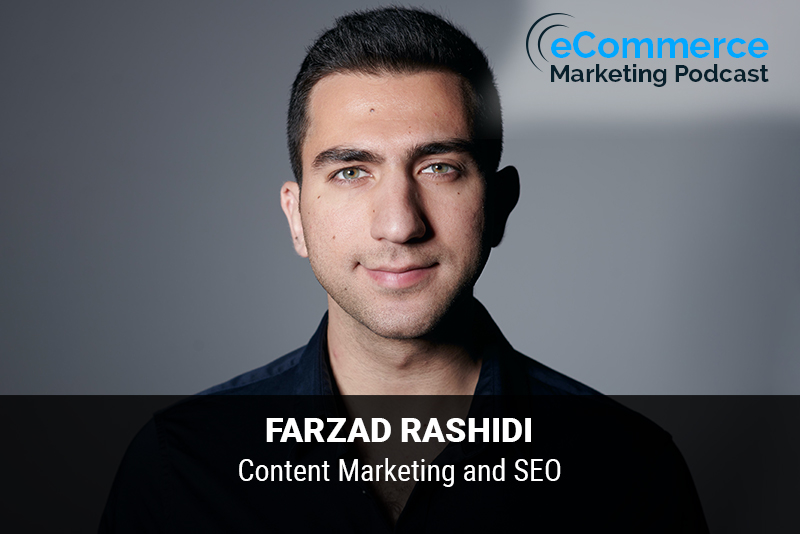
The eCommerce Marketing Podcast walks you through everything that goes into ecommerce marketing — from inbound marketing to paid advertising to conversions. Learn the strategies top marketing experts use to grow their businesses.
Today’s guest is Farzad Rashidi who is the lead innovator at Respona, the all-in-one digital PR and link-building software that combines personalization with productivity. He also runs the marketing efforts at Visme, where he helped the company gain over 12.5 million users and pass 2M monthly organic traffic. Since then, he’s been helping other companies achieve the same success via Respona.
In this episode, you will learn
- Must they have content marketing and SEO strategies that all ecommerce brands should be doing
- Evergreen content and how it is created and promoted
- How does an ecommerce brand know what types of content will resonate with their customers and potential customers
- Examples of businesses that have launched successful evergreen content marketing strategies
For show transcript and past guests, please visit https://www.ecommercemarketingpodcast.com
Or on YouTube at:
https://www.youtube.com/channel/UC3PgT0NOGzpdPGQtBK0XLIQ
Follow Arlen:
Twitter: https://twitter.com/askarlen
Facebook: https://www.facebook.com/arlen.robinson.7
Instagram: https://www.instagram.com/arlenyohance/
LinkedIn: https://www.linkedin.com/in/arlenrobinson/
Past guests on the ecommerce marketing podcast include Neil Patel, Nemo Chu, Luke Lintz, Luke Carthy, Amber Armstrong, Kris Ruby and many more.
Thanks for listening. Be sure to subscribe and leave a review.

In this episode of the eCommerce Marketing Podcast, host Arlen Robinson interviews Farzad Rashidi, Lead Innovator at Respona, an all-in-one digital PR and link-building software. Farzad also manages marketing efforts at Visme, where he has significantly contributed to the company’s growth. They discuss the importance of content marketing and SEO for e-commerce brands, focusing on strategies for acquiring customers via evergreen content.
Key Takeaways:
- Introduction to Farzad Rashidi (00:00:57)
- Farzad’s background, his role at Respona, and his significant contributions to Visme’s growth, achieving over 12.5 million users and 2 million monthly organic traffic.
- Challenges and Solutions in Content Marketing and SEO (00:02:46)
- Many e-commerce businesses struggle with content marketing and SEO, often focusing too much on content creation and not enough on promotion and link building.
- Importance of Keyword Research (00:06:49)
- Effective keyword research is crucial. Utilize tools like Ahrefs or SEMrush to identify high-traffic, low-competition keywords with high commercial intent.
- Building Evergreen Content (00:16:05)
- Evergreen content remains relevant over time and continuously attracts organic traffic. Focus on educational material and answer common questions related to your product or service.
- Promotion and Link Building Strategies (00:20:01)
- Invest more resources in promoting content and building backlinks rather than just creating content. High-quality backlinks significantly boost SEO rankings.
- Effective Link Building Techniques (00:20:34)
- Strategies include guest appearances on podcasts, affiliate marketing, and using outreach tools like Respona to find and connect with relevant publications.
- Examples of Successful Evergreen Content Strategies (00:26:47)
- Highlighting companies like Shopify and Ahrefs, which have effectively used evergreen content and free tools to drive traffic and engagement.
Bullet Points of Key Takeaways with Timestamps:
- [00:00:57] Introduction to Farzad Rashidi and his roles at Respona and Visme.
- [00:02:46] Common challenges in content marketing and SEO for e-commerce businesses.
- [00:06:49] Importance of keyword research and how to conduct it effectively.
- [00:16:05] Building evergreen content that remains relevant and attracts organic traffic.
- [00:20:01] Emphasis on promotion and link building over just content creation.
- [00:20:34] Practical link building techniques, including podcast appearances and affiliate marketing.
- [00:26:47] Examples of successful evergreen content strategies from Shopify and Ahrefs.
Guest Information:
Farzad Rashidi











